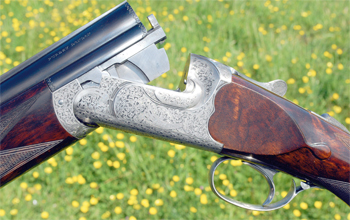Purdey Sporter 20-bore shotgun review

Purdey Sporter 20-bore shotgun review
Manufacturer: Purdey
Purdey Sporter shotgun in 12-bore form has received considerable positive attention since it was first launched in 2006.
Its shooting qualities and aesthetics are impressive. It is based on a generic Perazzi style barrel-action, much modified by Purdey and 60% made in the UK (the remaining work being undertaken by Perugini and Visini in Italy).
The Sporter project has been a rather brave undertaking by our most famous gun maker.
They got some stick for it initially. It was not justified; I don?t think anyone who has shot the production guns has anything other than praise for them. They not only look great and shoot extremely well, they are well priced too at a smidgen over £30,000.
And now a new small bore Sporter is being launched. It is built on a scaled-down action as a 20-bore, but 28-bore barrels will also be available.

I put the new 20-bore version through its paces with Purdey project manager Stephen Murray at the West London Shooting School. Stephen and I have been considering the form of the perfect sporting gun for over 20 years and no-one is better qualified to develop this new gun in my evidently biased opinion First impressions are very good.
With elegant scroll engraving and bolstered action it looks very smart. You would not mistake this for a Perazzi or Kemen on first glance. It has a character and distinct look of its own. In simple terms it looks like a London gun.
The finish, as one might expect is first class. It is best London style black and the well-figured and neatly chequered wood has been hand-rubbed.
The medium scroll engraving has a banner for the Purdey name on either action wall and a boldly engraved Purdey on the action belly.
The gun tested, a pre-production prototype, weighs in at 6lbs 12oz – no lightweight, but not far from my ideal weight for a 30? 20 bore over-under. I like the stock shapes too.
In particular, the well-radiused full pistol grip, the beautifully proportioned comb, and the rounded, but slim, fore-end. They look good and are ergonomically efficient, offering maximum purchase and control.
The stock of the prototype was a little low for my average 5?11? medium build frame and the balance a little butt/back heavy – both points which are being addressed as the gun evolves into its final form.
It is very fast handling in spite of its weight. It requires control if one?s preference is a neutral handling near-hinge-pin balanced gun, as mine usually is.

All small bores require extra work from the front arm if they are to be shot really well.
Small bores – and the smaller the bore the more this applies – have a tendency to ?rush to a stop?. They may also shoot higher than a larger bore gun with similar stock measurements.
The trigger pulls are good, though quite heavy. The production guns will break at 4, 4.1⁄2 or 5lbs.
With the dimensions suggested and a little less weight to the rear I have no doubt that this will be an outstanding gun to shoot. The basic form and quality are there.
The weight distribution in the barrels and the narrow, vent rib are near perfect. The same may be said of stock shapes.
This is no average production gun, but something that has the potential to sing. It is already a better gun than the Italian smoothbores that inspired it – better because there has been such obsessive attention to detail.
This test itself was part of the ongoing process of improvement. If by that you read that I am impressed by Purdey?s attitude to this project, then you would be absolutely right.
They are going to extraordinary lengths to make sure this new series of guns are as good as they possibly can be.

They are canvassing experienced opinion and listening to it. They start with their own unique strengths as builders of best guns by both traditional and high-tech methods.
The action has bifurcated lumps, trunnion hinging, and Boss-style bolting. The gun has 3? chambered monobloc barrels based on Purdey?s new screw-the-tube-into-the-monobloc system.
This, itself, is a major advance and much improves the joint between barrel and monobloc. The finely finished bores are 15.7mm. The norm for an English 20 bore is circa 15.6mm.
The bore has been opened out slightly ?to maximise the performance of the Teague choke system.?
It is not uncommon to find American and Italian 20-bore guns as open as 15.8mm or even 16mm. This tends to reduce felt recoil, and, provided cup wadded cartridges are used, range and penetration are not affected.
Purdey, however, are of the opinion that the range and penetration may be affected with UK type fibre wads.
My own experiments suggest that excessive back-boring can have significant effect with fibre wads, especially on cold days.
Though my preference is still for a bore around 16mm. Overall, this is another exceptional gun from Purdey.
With the modifications and tweaks as discussed, it would be hard to conceive of a better specification.
The gun is fundamentally sound in its design, beautiful, and the subject of a remarkable effort towards its perfection. One expects no less from the world?s greatest gun maker.
PRICE:
£30,000








